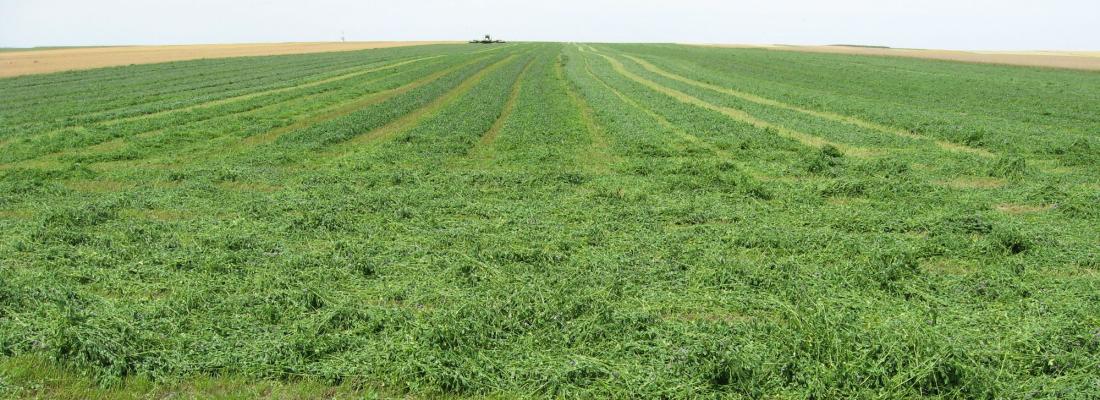France
September 11, 2023
Reducing greenhouse gas emissions is a key challenge in mitigating climate change, especially in agriculture. INRAE and the Université de Reims Champagne-Ardenne looked at the environmental footprint of the production of dehydrated alfalfa, a protein-rich food essential to ruminant farms and produced in France. The scientists calculated the environmental footprint from the moment the alfalfa is planted until it leaves the production unit, over two periods: from 2006-2009 and 2016-2019. Their findings, published in the Journal of Cleaner Production, reveal a significant decrease in the environmental footprint of dehydrated alfalfa production in France over time. Greenhouse gas emissions, for example, were divided by 2.3 between the two periods studied. This outcome meets the more global challenge of mitigating the environmental impact of livestock farming, as the use of dehydrated alfalfa can reduce imports of soybean meal.
 Decrease in the environmental footprint of dehydrated alfalfa — an essential livestock food © INRAE - Pascal THIEBEAU
Decrease in the environmental footprint of dehydrated alfalfa — an essential livestock food © INRAE - Pascal THIEBEAU
As a crop that fixes nitrogen, alfalfa is useful in reducing the reliance of agricultural systems on synthetic nitrogen fertilizers. Its high protein content also makes it an essential fodder plant in ensuring food sovereignty in the livestock farming of cows, sheep and goats in France. Produced domestically, alfalfa can help reduce the use of soybean meal, the majority of which is imported. It is a perennial crop, harvested between two and four years after it is sown, that also supports biodiversity by serving as a resource for pollinators and can potentially help maintain soil health. For alfalfa to be incorporated into animal feed, it must be dehydrated in ovens after drying in the field. Dehydration is an energy-intensive process, so it is important to calculate the environmental footprint of this production to assess progress made and reduce impact. Scientists performed a life-cycle assessment for the three steps of this production: production in the field, transportation from the field to the factory and the dehydration process. To assess how the environmental footprint of alfalfa has evolved over time, calculations were based on the periods 2006-2009 and 2016-2019. Twelve production units, eight of which are located in eastern France (where most the country’s alfalfa is grown) were included in the study. Over 50% of France’s dehydrated alfalfa is produced in these units.
An environmental footprint halved in 10 years
Results show that innovation and the renewal of production tools between the two periods reduced fossil fuel energy consumption. In 2006-2007 most of the furnaces used to dehydrate alfalfa were heated to 750°C and used mainly lignite and coal as energy sources. Over the years, the equipment has been replaced by low-temperature ovens that operate at 250°C, thus lowering overall energy consumption. Production sites also equipped these furnaces with biomass injectors to use renewable energy sources such as wood, miscanthus and other agricultural and forest-based co-products. As a result, in 10 years the use of lignite and coal has been divided by 3.5, falling from 352 to 100 kg per tonne of dehydrated alfalfa between 2006-2007 and 2016-2019. In parallel, the introduction of renewable energy to dehydrate alfalfa increased to 127 kg of biomass per tonne of dehydrated alfalfa in 2016-2019. However, the increased use of renewable biomass has amplified the overall environmental impact of production in terms of ‘land use’ (from 0.840 to 1.222 square metres per year) since it automatically includes the use of land for the production of wood or energy crops.
Another factor that contributed to a smaller environmental footprint for dehydrated alfalfa was an increase in the amount of time alfalfa spent drying in the field before harvest, evolving from two to three hours to 48 hours, together with climate change. This technique has made it possible to reduce the water content of harvested alfalfa, which, in conjunction with a generally warmer and drier climate, has greatly reduced energy consumption for transportation and oven dehydration. There is one risk, however: if the alfalfa is too dry when harvested, mechanical operations may cause the leaflets to fall off, which diminishes its protein content.
Overall, the dehydrated alfalfa industry in France thus divided its greenhouse gas emissions by 2.3, from 1.150 to 0.494 kg CO2-eq of dehydrated alfalfa dry matter between 2006-2009 and 2016-2019. This development is good news for the fight against greenhouse gas emissions, particularly in agriculture, a sector that is difficult to decarbonise.
Reference
Thiébeau P., Auberger J., Clivot H. et al. (2023). Environmental footprint of dehydrated alfalfa production (Medicago sativa L.) in France. Journal of Cleaner Production, 138704, DOI : https://doi.org/10.1016/j.jclepro.2023.138704